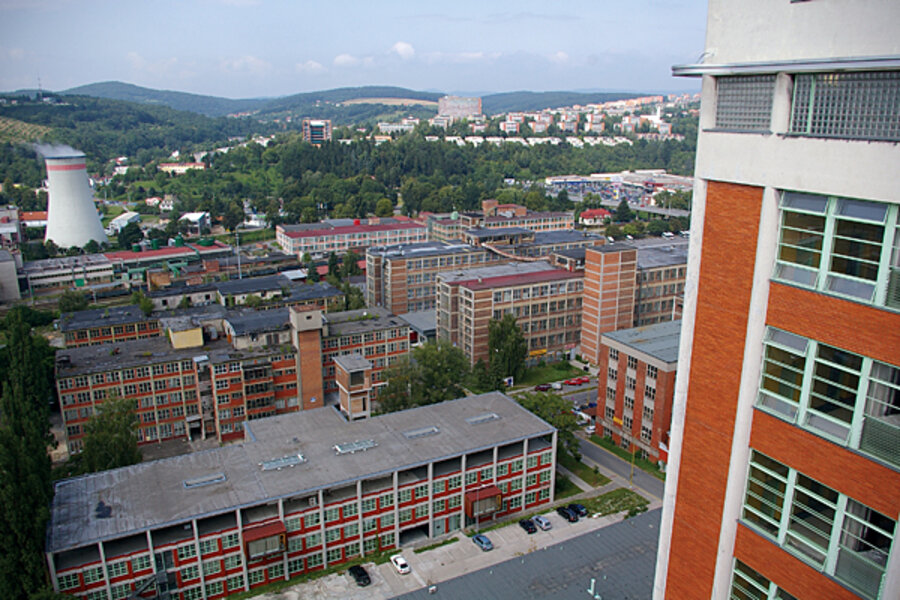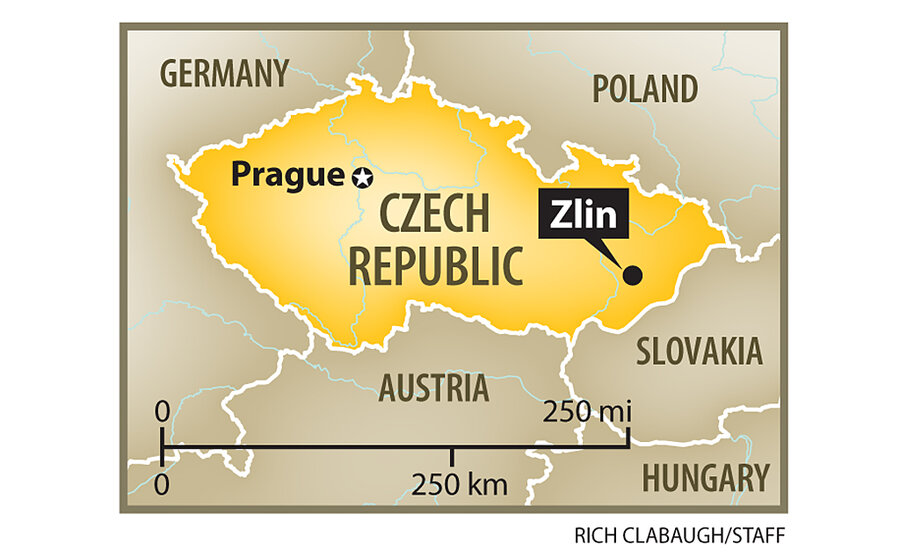Workers' paradise: The town built by Czech version of Henry Ford
Loading...
| Zlin, Czech Republic
Shoes have long been at the center of life in this small city in the hills of eastern Moravia.
It was built by a local cobbler, Tomas Bata, to serve what would become the world's largest shoe company. Tens of thousands worked directly or indirectly for Bata Shoes before World War II or for its Communist successor, Svit.
Today, much of the complex stands empty, windows broken and walls covered with graffiti. An icon of early 20th-century industrial architecture, the antiquated factory was unable to survive the loss of the Soviet market and competition from Asian producers after 1989.
But unlike many other East European industrial cities, Zlin has weathered the transition remarkably well. Streets bustle with commuters, university students, and businessmen. The Golden Apple shopping mall teems with shoppers. Hundreds of small firms and retail outfits fill nearby Bata-era civic buildings. A philharmonic hall and conference center is taking shape next to the striking new headquarters of the nine-year old Tomas Bata University, where 12,000 students now study.
Instead of becoming a Rust Belt city, Zlin is a confident, modestly prosperous university town, with an unusual concentration of small businesses. And it has become so despite its backwater location and poor transportation links.
The Henry Ford of Moravia
The reason, residents say, is the legacy of Tomas Bata and his brother Jan, who built Zlin as an industrial utopia. "The approach toward free enterprise ... managed to survive," says Zdenek Pokluda, director of district archives.
Inspired by visits to Henry Ford's River Rouge plant and the Endicott-Johnson shoe plant in 1919 and 1920, Tomas Bata built assembly line factories in his village and surrounded them with a model "garden" city.
At a time when many Czechs lacked power or running water, Bata built thousands of brick houses for workers, each with indoor plumbing, electricity, balconies, and a garden. He constructed a hospital, department stores with subsidized prices, sport facilities, parks, and the country's largest movie theater. Managers were trained in the company business school; marketers, in its film school; designers, in its art institute. Workers had free healthcare and schooling and some of the top wages in the country. Bata, who was mayor, controlled everything.
In the process he created what was, until the mid-1990s, the world's largest footwear firm, as well as one of the most famous achievements of modern architecture: a modernist city spreading out from the 16-story Bata headquarters. As Bata expanded overseas, it built "Zlins" in Canada, India, and Pakistan.
"He wanted to prepare completely educated, highly skilled, active people who could live anywhere," says Pavel Velev, executive director of the Thomas Bata Foundation, which is named after Tomas's son.
'Class enemies'
But the dream came to an end after the Soviet takeover. The Batas – "class enemies" – fled to Canada and Brazil. The factory was nationalized and produced cheap footwear, while the city was renamed Gottwaldov, after the country's Stalinist dictator. "The Bata name was forbidden," recalls Mr. Velev.
But not forgotten. The Batas had trained thousands of engineers, scientists, designers, doctors, and other professionals who continued to staff area schools, farms, and factories. "They ... passed on their thinking to their children and grandchildren," says Miroslava Stybrova, curator of the Zlin Shoe Museum.
Even under the Communist regime, a Bata-esque empire emerged on a cooperative farm in nearby Slusovice. The director gave managers wide autonomy and encouraged innovation. By the mid-1980s, the "farm" made PCs, software, tractors, fertilizers, insecticides, and processed dairy goods. It raised racehorses, mastered embryo transfer techniques for cows, and provided construction services. It ran its own management schools, health centers, and recreational facilities.
"Slusovice was like a little capitalist town in a communist country," recalls Jan Zamazal, who teaches shoe design at Tomas Bata University. "This economic miracle was backed up by reformers in the government, but it was following the model of Bata."
A cobbler's legacy
The farm was disbanded after the "Velvet Revolution." But "many of the companies around here today were started by people involved with Slusovice," says Jana Buch, head of the university's product design department. "They had seen what could be accomplished with hard work and good thinking, and they were ready to take responsibility for their own life."
Even after the Svit shoe company collapsed in the 1990s, people found jobs in hundreds of new start-ups, more than any other city save Prague. The university, founded in 2001, is an economic engine.
Zlin still faces many challenges. Parts of the 96-acre shoe factory have been renovated, but most remain derelict. Regional wages are low and unemployment growing. But locals say Bata's spirit of innovation lives on.
"The worst damage the Communists did to people was to take away any responsibility so they would just be standing waiting for someone to tell them what to do," Ms. Buch says. "That's the difference between Zlin and many other places. People know they can do it."






